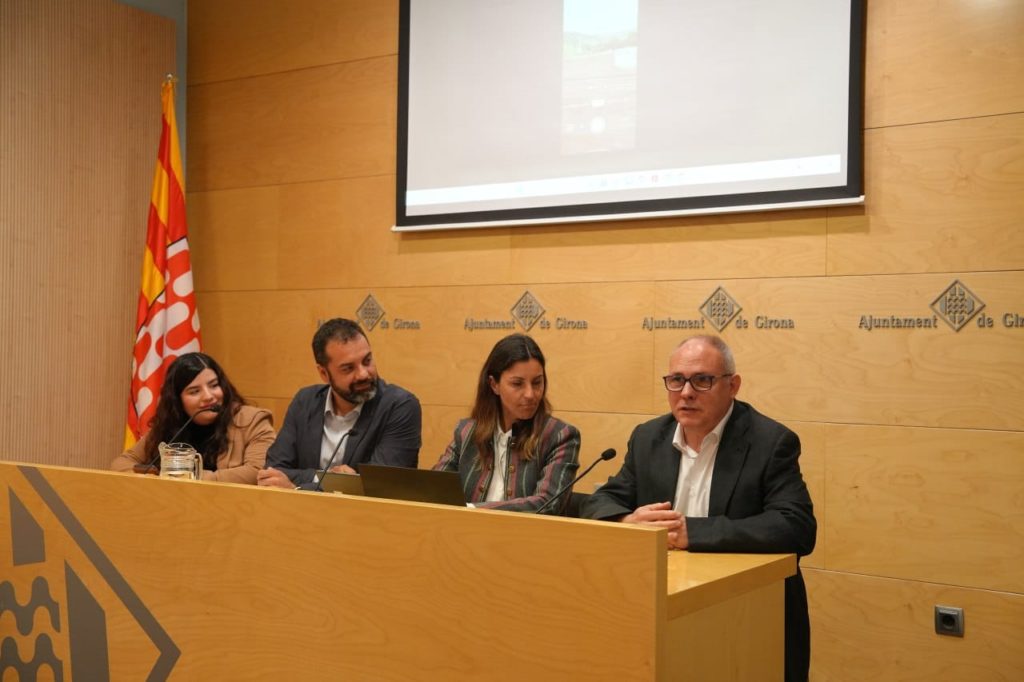
- The projects allow users to view in 3d, directly from the browser on any mobile device, the iconic tower in Girona as it was in the 14th century and the Iberian city of Ullastret as it stood in 250 BC, creating an educational, inclusive and immersive experience with no need to download any app
- Both initiatives are part of the Àrees Digitals programme, driven by the Government of Catalonia through the Secretariat for Digital Policies, Mobile World Capital Barcelona and the i2CAT research centre, and are supported by local institutions to bring culture closer to the public through advanced digital technologies
- The two projects were presented this Tuesday at a press conference

06/May/2025
Girona’s Torre Gironella and the Iberian city of Ullastret have regained their original appearance in a virtual environment thanks to the launch of an innovative technology pilot that brings together heritage and technology through an immersive experience using augmented reality and 5G technology.
The two pilots have been promoted under the Àrees Digitals initiative, led by the Government of Catalonia through the Secretariat for Digital Policies, Mobile World Capital Barcelona and the i2CAT research centre. They demonstrate the transformative potential of digital tools to enhance the value of historical heritage.
The Girona Virtual project restores the medieval splendour of Torre Gironella, offering a digital reconstruction of the tower as it stood in the 14th century. Anyone can explore it via their mobile phone browser, with no need to download an app. Users can move freely around the environment and, by scanning QR codes, view the original appearance of the site from different angles using augmented reality, with contextual information on the architectural and historical elements.
Torre Gironella, located at the highest point of Girona’s Roman wall, is a fortification with remains dating back to Roman times. Rebuilt over the centuries, it was a symbol of power and resistance until its destruction in 1814. Now, thanks to technology, it rises once again—virtually—above the city.
Meanwhile, the Ullastret Virtual initiative offers an interactive experience at the Iberian city of Ullastret, based on a virtual reconstruction developed through the “Heritage in Action” programme, promoted by the “la Caixa” Foundation. Following the same technological model as Torre Gironella, QR codes placed along the archaeological route allow visitors to access virtual reconstructions of key areas of the settlement as it would have looked 250 years before Christ.
During the press conference presenting both projects, Joaquim Ayats, Girona’s Second Deputy Mayor and Councillor for Culture, stated: “With this project, we aim to recover Girona’s historical heritage to understand where we come from and how our identity is built.”
The Director General for Digital Economy and Societies of the Government of Catalonia, Sandra Ruiz, highlighted that “today we’re presenting the first pilot projects within the Girona Digital Area, and we’re especially excited about it. These are two pilots in the fields of Tourism and Culture, which have been identified as priority areas for this Digital Area to achieve the overarching goals of the initiative: to drive the digital ecosystem across Catalonia, boosting each territory’s social and economic activities through training and digital innovation, using so-called advanced digital technologies.”
Meanwhile, Eduard Martín, CIO of Mobile World Capital, remarked that “projects like Torre Gironella and the Iberian settlement of Ullastret show the potential of technology to enrich our heritage and serve people.” At the same time, Carlota Gallés, Head of Territorial Innovation at i2CAT, added that “the Digital Areas project aims to root technology in local communities and make it accessible for companies, public institutions, schools and citizens.”
A collaborative project
Both initiatives are part of the Girona Digital Area strategy and are supported by local institutions to bring culture closer to the public through advanced digital technologies.
The Torre Gironella pilot has been led by CIFOG – Girona Vocational Training School, the Government of Catalonia, the i2CAT research centre and Mobile World Capital Barcelona, with the collaboration of Girona City Council, the Girona Chamber of Commerce, Girona Provincial Council and the University of Girona.
The Ullastret project, in turn, has been produced by the Archaeology Museum of Catalonia and the company Tururut Art Infogràfic, promoted by the Government of Catalonia, the i2CAT research centre and Mobile World Capital, with the support of the Girona Chamber of Commerce, Girona City Council and Girona Provincial Council.
Stay up to date about everything
Subscribe to stay up to date with the latest content from Mobile World Capital Barcelona.